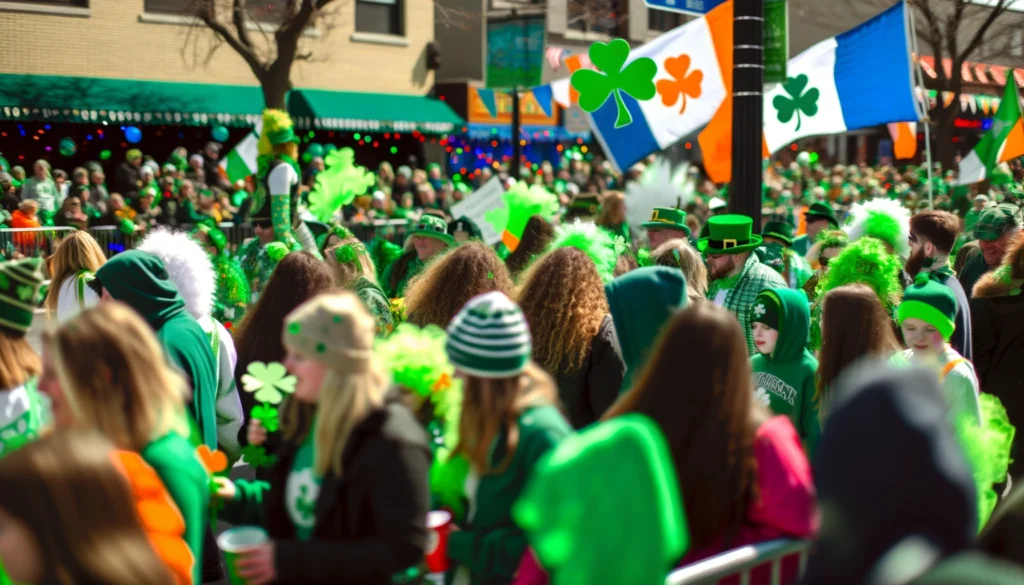
St. Patrick’s Day, celebrated on March 17th, honors St. Patrick, the patron saint of Ireland. This cultural and religious celebration marks the date of St. Patrick’s death and commemorates Irish culture with parades, special foods, music, dancing, and a lot of green. The day is recognized globally, with people embracing Irish traditions, wearing green, and participating in various festivities, regardless of their ethnic background.
Table of Contents
A2 Level Questions:
- What is St. Patrick’s Day?
- When do we celebrate St. Patrick’s Day?
- Why do people wear green on this day?
- Can you name a food that people eat on St. Patrick’s Day?
- What is a common symbol of St. Patrick’s Day?
- Do you know any Irish music or dances?
- Have you ever seen a St. Patrick’s Day parade?
- What do people do to celebrate St. Patrick’s Day?
- Why is St. Patrick important in Ireland?
- Do people in your country celebrate St. Patrick’s Day?
- How do you think you would celebrate St. Patrick’s Day?
- What colors do you see a lot on St. Patrick’s Day?
- Do you know any stories about St. Patrick?
- Would you like to visit Ireland on St. Patrick’s Day? Why?
- What do you think “luck of the Irish” means?
- Can you draw a shamrock? What does it represent?
- Do you know any Irish fairy tales or legends?
- What might you say to someone on St. Patrick’s Day?
- Have you ever tried Irish food or drinks?
- What would you like to learn about Irish culture?
B1 Level Questions:
- How is St. Patrick’s Day celebrated differently around the world?
- What historical significance does St. Patrick’s Day hold?
- Discuss the impact of St. Patrick’s Day on promoting Irish culture.
- How has the celebration of St. Patrick’s Day changed over time?
- What are some traditional Irish foods and drinks consumed on St. Patrick’s Day?
- Can you explain the significance of the shamrock in Irish culture?
- What role do parades play in St. Patrick’s Day celebrations?
- How do people of non-Irish heritage participate in St. Patrick’s Day?
- What are some common misconceptions about St. Patrick’s Day?
- Explore the themes of luck and fortune associated with St. Patrick’s Day.
- How do schools and communities typically celebrate St. Patrick’s Day?
- Discuss the importance of music and dance in St. Patrick’s Day festivities.
- What are some ways to celebrate St. Patrick’s Day sustainably?
- How do businesses capitalize on St. Patrick’s Day?
- What is the story behind St. Patrick driving the snakes out of Ireland?
- Discuss the global influence of Irish culture as seen on St. Patrick’s Day.
- How do you think St. Patrick’s Day promotes unity and inclusion?
- What is your favorite St. Patrick’s Day tradition, and why?
- How do you think St. Patrick’s Day celebrations differ in urban vs. rural areas?
- What lessons can we learn from the stories and legends associated with St. Patrick?
B2 Level Questions:
- Analyze the significance of St. Patrick’s Day in global cultural exchange.
- Discuss the commercialization of St. Patrick’s Day and its impact on cultural authenticity.
- How do Irish diaspora communities maintain their cultural heritage through St. Patrick’s Day?
- Compare and contrast St. Patrick’s Day celebrations in different countries.
- Explore the role of religion in the historical and contemporary observance of St. Patrick’s Day.
- Evaluate the impact of globalization on St. Patrick’s Day celebrations.
- Discuss the symbolic meanings of St. Patrick’s Day icons like the leprechaun and pot of gold.
- How has the narrative of St. Patrick’s Day evolved in popular culture?
- What are the environmental impacts of large-scale St. Patrick’s Day celebrations, and how can they be mitigated?
- How do St. Patrick’s Day celebrations foster community spirit and cohesion?
- Examine the importance of storytelling and folklore in Irish culture, highlighted during St. Patrick’s Day.
- Discuss the balance between celebrating a national identity and embracing multicultural participation on St. Patrick’s Day.
- How do educational institutions use St. Patrick’s Day as a tool for cultural education?
- Analyze the role of media in shaping perceptions of St. Patrick’s Day.
- What are the challenges and benefits of organizing large public events for St. Patrick’s Day?
- Explore the significance of traditional Irish music and dance performances on St. Patrick’s Day.
- How does St. Patrick’s Day contribute to the tourism industry in Ireland?
- Discuss the importance of color symbolism in St. Patrick’s Day celebrations.
- Examine the influence of St. Patrick’s Day on promoting Irish literature and art.
- How do modern St. Patrick’s Day celebrations reflect the changing nature of Irish identity?
C1 Level Questions:
- Critically assess the role of St. Patrick’s Day in the commodification of national culture.
- Explore the interplay between St. Patrick’s Day celebrations and global perceptions of Irishness.
- Analyze the socio-economic impact of St. Patrick’s Day on the hospitality and retail sectors.
- Discuss the potential for cultural dilution amidst the global spread of St. Patrick’s Day festivities.
- Evaluate the effectiveness of St. Patrick’s Day as a platform for cultural diplomacy.
- Investigate the historical accuracy of St. Patrick’s legends and their relevance today.
- Debate the merits and drawbacks of the extensive commercialization of St. Patrick’s Day.
- Examine the role of St. Patrick’s Day in the construction and negotiation of Irish-American identity.
- Analyze the impact of St. Patrick’s Day on national and international branding of Ireland.
- Explore the ethical considerations of marketing cultural and religious holidays.
C2 Level Questions:
- Theorize the cultural globalization phenomenon through the lens of St. Patrick’s Day celebrations.
- Discuss the implications of St. Patrick’s Day for the conceptualization of national identity in a globalized context.
- Analyze the role of St. Patrick’s Day in the politics of memory and heritage.
- Examine the intersection of commerce, culture, and tradition in the celebration of St. Patrick’s Day.
- Critique the representation of Irish culture in international St. Patrick’s Day celebrations.
- Evaluate the role of St. Patrick’s Day in fostering a global Irish diaspora community.
- Discuss the impact of digital media on the spread and evolution of St. Patrick’s Day celebrations.
- Explore the potential of St. Patrick’s Day to challenge stereotypes and promote cultural understanding.
- Analyze the implications of St. Patrick’s Day for cultural appropriation debates.
- Examine the dynamics of cultural assimilation and preservation within St. Patrick’s Day festivities.

